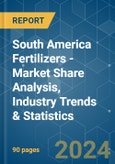The South America Fertilizers Market size is estimated at USD 49.35 billion in 2024, and is expected to reach USD 68.66 billion by 2030, growing at a CAGR of 5.66% during the forecast period (2024-2030).
Key Highlights
- Fastest growing segment by Product - Manganese : Manganese availability in soil decreases with rising pH and is less mobile in the plants thus affecting the young parts of the plant which requires application of fertilizer.
- Largest Segment by Crop Type - Field Crops : The domination of field crops in South America Fertilizers market is mainly due to its large cultivation area in the region. They account for more than 95% of total crop area.
- Fastest growing by Speciality Type - Liquid Fertilizer : Liquid fertilizers can penetrate the the soil easily allow plants to absorb nutrients more quickly, reduce fertilizer waste and can be applied to either ground or foliar.
- Largest segment by Country - Brazil : Brazil alone accounts for about 61% of the total crop area in the South American region. Which is about 74.61 million hectares of agricultural land in the country.
South America Fertilizers Market Trends
Field Crops is the largest segment by Crop Type.
- The overall fertilizer consumption by different crops has grown by 31.65% value and is estimated to record a CAGR of 7.53% during the forecast period. By volume, the overall consumption accounted for a growth of 17.4% and is estimated to record a CAGR of 4.2% during the forecast period.
- By crop type, field crops are dominating the market by 75.9%, followed by horticultural crops with 23.8% of fertilizer consumption value. Both horticultural and field crops are essential to the country's trade and consumption, and the increased domestic and international demand are bolstering the segment's growth.
- The area under cereals cultivation has increased by 8.73% during the study period. With important crops being cultivated in the country, such as soybean, corn, and wheat, among others, the country is actively importing fertilizers to meet the domestic demand, which is driving the growth of the segments.
- Accordingly, Free trade agreements (FTAs) between the United States and Chile and several Latin American countries have been a major factor in the increase in fruit and vegetable production in South American countries over the last few decades. These FTAs, including NAFTA (USMCA), CAFTA-DR, and bilateral agreements with countries such as Chile, Colombia, Panama, and Peru, are expected to further boost fertilizer demand in the region.
- Therefore, based on the aforementioned characteristics, the market for fertilizers is anticipated to grow during the forecast period.
Brazil is the largest segment by Country.
- Fertilizer consumption measures the amount of plant nutrients used per unit of arable land. According to our analysis, Brazil accounts for 66.0% of the total domestically used fertilizer in South America. By fertilizer type, conventional fertilizers dominated the Brazilian fertilizer market and accounted for 63.1%, followed by specialty fertilizers contributing 36.8% in 2021.
- Argentina is one of the world’s major exporters of wheat and soybean, and the share of agriculture contributes to 5.9% of Argentina's gross domestic product. Argentina accounted for 5.7% of the South American fertilizers market in 2021. By fertilizer type, specialty fertilizers recorded the largest share of 59.4%, followed by conventional fertilizers accounting for 40.5% in 2021. Among specialty fertilizers, liquid fertilizers account for 31.2%, followed by water soluble fertilizers for 20.8%, controlled-release fertilizers accounting for 5.7%, and slow-release fertilizers contributed 1.5% of the Argentine fertilizers market.
- Field crops dominated the South American fertilizers market by accounting for 95.0% of the market share in 2021. The top three crops grown in South America were soybeans, corn, and sugarcane, which have increased significantly over the past two decades. Production is expected to continue to rise as growers in countries such as Brazil continue to expand the planted area and push for higher yields.
- In South America, the area harvested under major food crops has been continuously increasing, mainly due to the growing population and related increase in demand for food grains. Hence, the fertilizer market in the region is expected to grow during the forecast period.
South America Fertilizers Industry Overview
The South America Fertilizers Market is fragmented, with the top five companies occupying 31.30%. The major players in this market are Israel Chemicals Ltd, K+S AKTIENGESELLSCHAFT, Nutrien Limited,, The Mosaic Company and Yara International ASA, (sorted alphabetically).Additional Benefits:
- The market estimate (ME) sheet in Excel format
- 3 months of analyst support
Table of Contents
1 EXECUTIVE SUMMARY & KEY FINDINGS2 REPORT OFFERS7 KEY STRATEGIC QUESTIONS FOR FERTILIZER CEOS
3 INTRODUCTION
4 KEY INDUSTRY TRENDS
5 MARKET SEGMENTATION
6 COMPETITIVE LANDSCAPE
8 APPENDIX
Companies Mentioned (Partial List)
A selection of companies mentioned in this report includes, but is not limited to:
- compo-expert
- Fertgrow
- Haifa Negev technologies LTD
- Israel Chemicals Ltd
- K+S AKTIENGESELLSCHAFT
- Nortox
- Nutrien Limited,
- Sociedad Química y Minera (SQM)
- The Mosaic Company
- Yara International ASA,
Methodology

LOADING...










